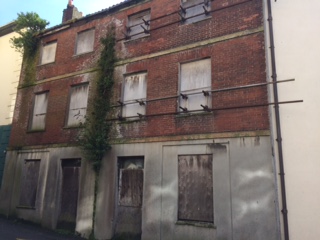A lot is said about how beautiful our island is – quite rightly. But when it comes to certain parts of our built landscape, it is difficult not to be critical.
The picture above shows the façade of a former office building in the very heart of Town. It has been standing unoccupied for more than 20 years, probably longer. Behind it is a courtyard open to the skies, with some protective netting strung across it. It is used only by pigeons.
This dilapidated and presumably valuable piece of real estate stands behind the Swan Inn and HSBC’s offices in the lower Canichers off St Julian’s Ave. It is one of the eyesores we tolerate, unnoticed only because we have become used to it.
And once you start looking, it is easy to find other eye irritants:
Hotels that have checked out but never left.
These include the dilapidated edifices of St Martin’s Hotel off Les Merriennes in St Martin, the empty shell of the Bon Port hotel in St Martin with its fine view across to Jerbourg and Jersey, the forlorn Le Chalet at Fermain – and most pitifully the burned-out derelict ruin of Idlerocks Hotel on the Jerbourg peninsula. The architect behind a hotel redevelopment for the Idlerocks believes he’ll never see it happen.
Government buildings which reflect an apparent architect shortage when conceived.
One thinks here of Charles Frossard House, States Works on the North side of the Bridge in St Sampson, the Customs shed at the harbour, and the former HQ of Guernsey Telecom in Upland Road.
Some historic edifices could with hard work make our island even more attractive to visitors: the unpreserved and unrestored historic castle at Chateau des Marais near the Grand Bouet, for example, plus Vale Castle, places like Fort Richmond and Fort Doyle, and the crumbling church in Brock Road.
But it would be expensive. Still more expensive would it be to deal with other remnants of our past: the shattered tumbledown glasshouses all over the island, and the multiple isolated structures with asbestos.
The case for modernisation is stronger when it comes to the vast car parks in the harbour area, which from vantage points like La Fregate have always looked like the output of an auto factory. That, no doubt, is why the States is now exploring a harbour area plan. But we should keep in mind what has happened with the other harbour area at the Bridge. The ambitious and detailed plans outlined for its development have apparently run into the sand.
With respect to both Town and the Bridge, meanwhile, it would be helpful if occupants could be found for the dozens of void retail premises in these areas – that would certainly make them look a lot brighter. Some believe this problem is the result of internet shopping. One suspects that it is associated more with unwilling landlords than with unwilling tenants.
These various blemishes, fortunately, seem unlikely to spoil the impression most tourists will form on a brief cruise ship visit to the island. But one of the misfortunes resulting from the understandable need to film “The Guernsey Literary and Potato Peel Pie Society” in Devon and Cornwall is that those attracted to the island by what they see in the movie may find the physical reality of modern Guernsey a disappointment.
What all this signals to those living here is less obvious. A shortage of resources perhaps, or at least an unwillingness to invest more than is absolutely necessary. Faults with the island’s development plans maybe? Or with our planning system? With our sense of aesthetics? Or with the priority we give to development generally, or to tourism in particular? These are not questions with easy answers. But the results have become a bit too obvious.







